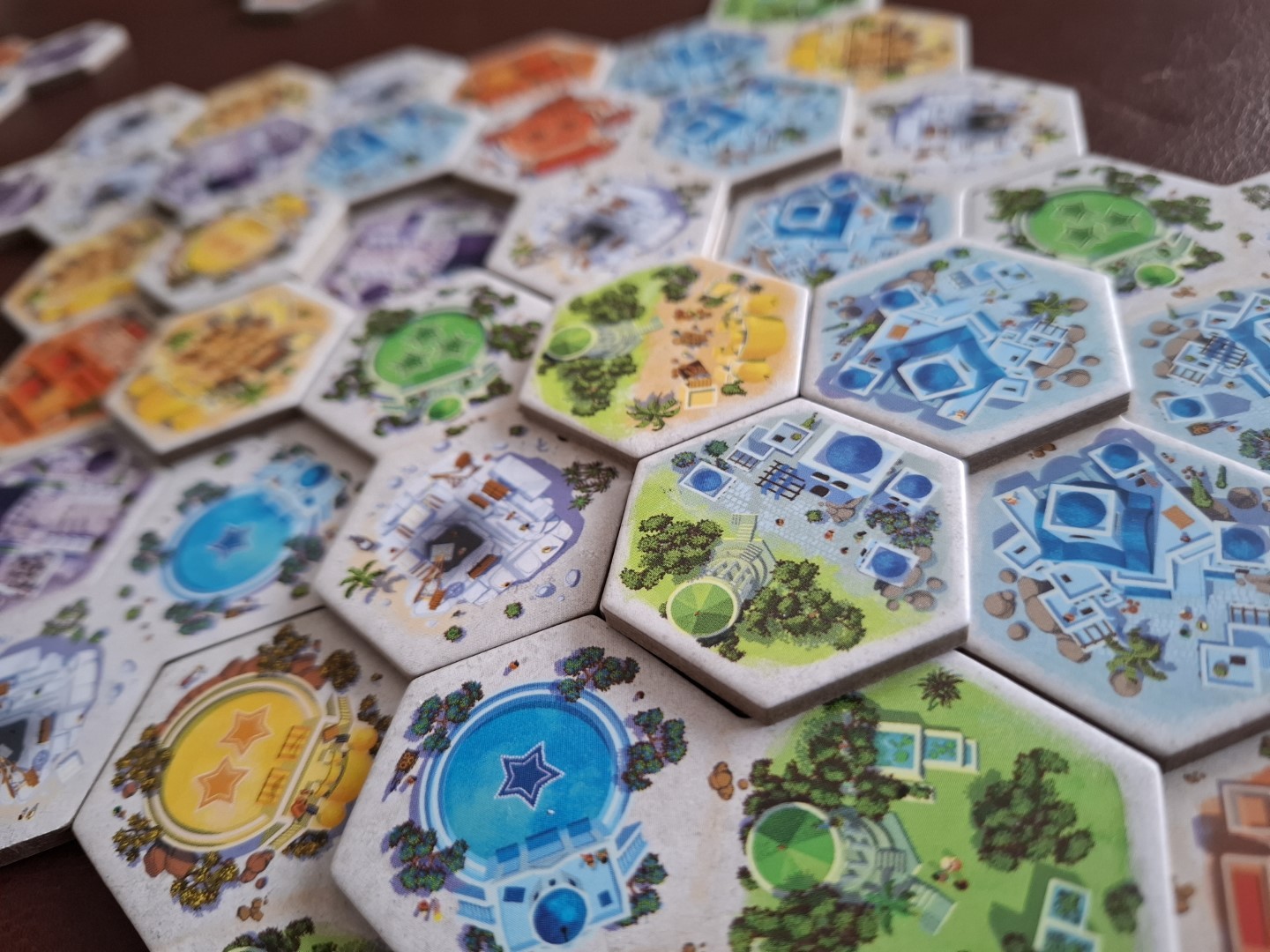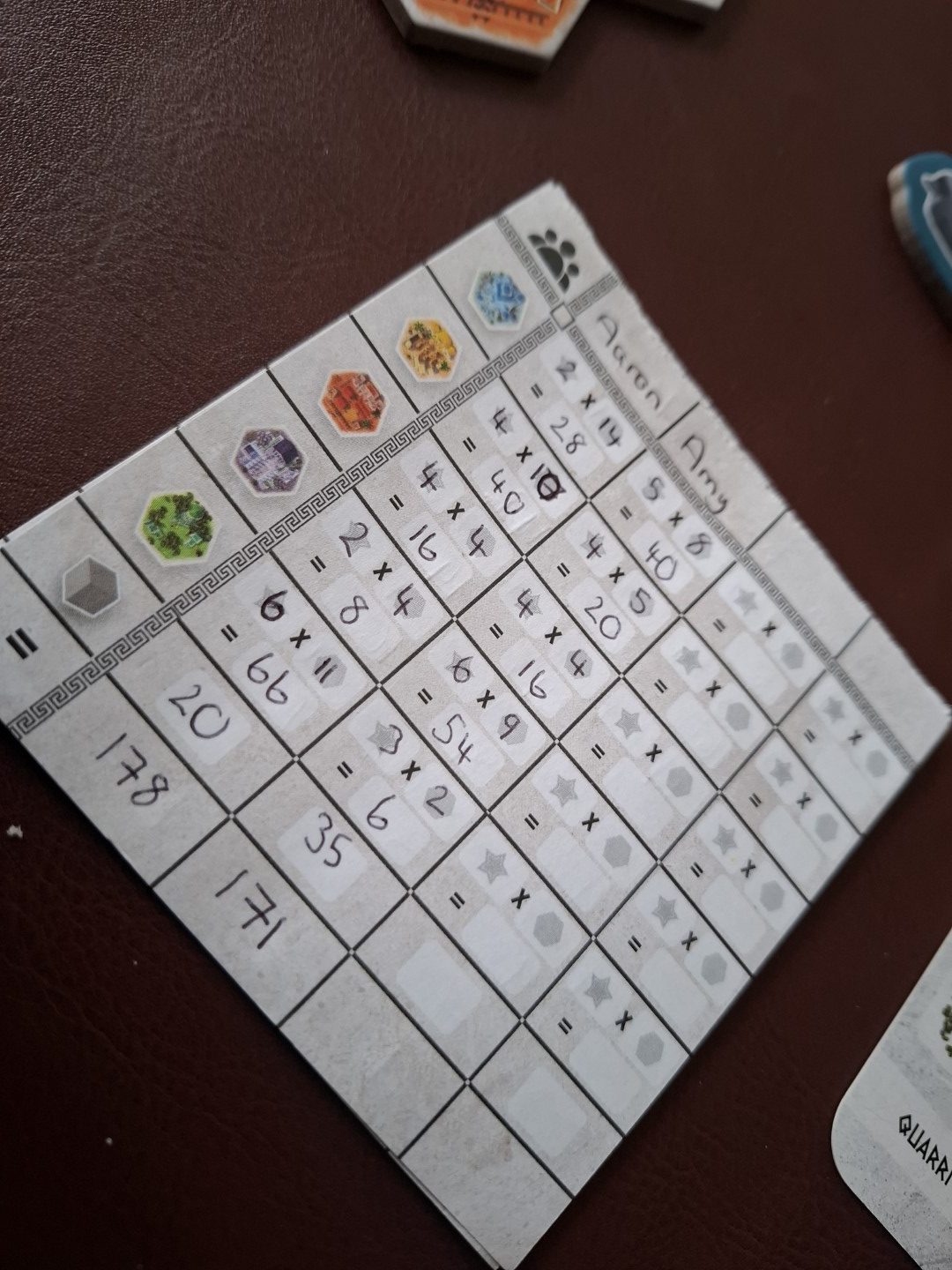I guess we should start with the disclosure that I have played Akropolis 43 times, some would say that’s alot! But I suspect that someone will say its not, my average score is 136, my highest score is 350, the highest score I’ve seen is 362 (in a two player game with all the tiles). And that’s important for the summary, however, before we get there we should talk about how the expansion Athena plays (or maybe what it adds!).

Athena doesn’t fundamentally change the game rules or the starting setup, it just adds. So at the start of the game you shuffle the deck of construction cards(effectively goal/objective cards), deal out four, and add 4 tiles below each and then place pieces of the Athena statue with these construction cards (heads, torsos, pairs of legs and pedestals.

These cards add goals you want to try and complete through the game to a) gain an immediate bonus b) if you complete each goal, increase the end game scoring of stones. Akropolis is played as normal, in that on your tile you select a tile and add it to your Akropolis, and then after placement you may claim a construction card, by taking the part of the Statue of Athena for that Construction card and then a single tile which you add to your city. You can complete multiple construction cards on a turn (in the order of your choice).

Once you’ve completed a construction card, you can’t complete it again. At the end of the game, if you completed the statue of Athena, you’ll score 5 points for each stone at the end of the game, instead of the usual 1 point per stone. That’s it. Just a few minor tweaks, and it’s easy enough to add into the game.

But in summary? Well I love and don’t love Athena. I love Athena because it adds this combo type element coupled with objectives to work towards, which I think changes the point scoring potential.

Throw in the expansion and all the tiles, well after 6 games, my expansion average score is 170, and in the two player game with all the tiles, the other player scored 530 points! I scored 420. And I think that is what Athena does, it elevates the point scoring potential of the games.

But what I don’t like, well I’m not sure the setup of take all 18 cards and shuffle is perfect. Why? Because you can end up with games where all the goals are around the same colour districts and plaza’s, take one our recent games, where we had multiple red construction cards. There are a total of 7 red districts required to complete them all, the setup has a total of 10 districts.

Therefore, making achieving some of these goals somewhat unachievable, and in 6 of our games, we’ve had games where neither of us have completed all the construction cards and others where one player has complete all the construction cards and therefore unlocked end game scoring, whilst the other player hasn’t. Now you might say, well that’s just unfortunate, or it won’t be possible to complete every card every game.

I would say, that’s a fair comment, however, when the ability to achieve them is limited by the components? Now you could say that changes the nature of the game and suddenly makes some tiles more attractive and the use of stone even more important. And that’s true, but lets say you complete the statue, suddenly spending 15 points or more (stone is 5 each) to take a tile further in the line up, takes a completely different perspective. I feel a quick fix could be to have some of the decks sorted into a, b, c, d or just a and b, and take one or two from each deck to reduce the chances of multiple constructions from the same district.

I also think some of the wording is unclear, by the clarifications provided on some and not the others, for example some cards say “adjacent” other cards don’t. Each construction card provides a layout summary and then explanatory text, now the layouts are generally all shown as being adjacent, however, only some of the explanatory texts include the word “adjacent”. Other cards do say around, surrounded, but for example the line construction cards – they say a line, the picture shows them in an adjacent line in a certain order. But the explanatory text doesn’t offer clarification on whether they need to be in that order, or whether they need to be adjacent. Those cards are open to interpretation (we’ve sat and debated with different players!).

But I love having an element that changes the way people value tiles, and then this is almost counterbalanced by the potential that the resource you’d spend being worth more. This puts the decision of spending more stone to get those tiles to complete goals vs trying to retain stone to maximise end game scoring (assuming you complete all the construction cards).

Components wise, the statue tiles are chunky, the single tiles are likewise of a similar quality to that of the original, they do have a slightly different tone to the original tiles and they appear to be a tiny tiny bit thinner (I’m talking less than a millimetre). The backs are lighter(not a big deal as they are separate), the plazas and districts are again marginally different. The green is lighter, the yellow, red and blue districts are more subdued, whilst the purple seem to be a 100% match. Now this isn’t game breaking and you can only tell by placing them side by side and we didn’t notice whilst playing.
As you know I rate games on a scale of:
Buy or play
Wait for sale or play if you like games XYZ
Avoid

As an expansion, I’m not sure its a “Buy” as if you love the core experience of Akropolis this does fundamentally tweak that and changes the way individuals will approach the game. I think this is a “play”, that probably includes people who haven’t play Akropolis before – because Akropolis is great. Although I’d say that you’d want to play original/base Akropolis first before playing Athena. If you don’t love Akropolis? I don’t think this will change your mind.

So in summary, If you love Akropolis as it is, and feel like it doesn’t anything else? Then you probably don’t need Athena – Athena doesn’t feel essential, its just more in a way that you could order a side to your main meal, it isn’t always required. But maybe you played Akropolis and felt it just needs bit more, then Athena is worth a try (not necessarily a buy!).

